Biological Activities and Chelating Properties of New Benzoyl Derivatives of 2-Substituted Benzimidazoles
| Received 30 Jul, 2022 |
Accepted 05 Sep, 2023 |
Published 02 Nov, 2023 |
Background and Objective: Increasing prevalence of bacterial infections as well as the resistance of some existing drugs necessitates the need for further research for compounds with more effective activities. Thus, this study synthesized benzoyl derivatives of 2-2-substituted benzimidazoles, evaluated their chelating properties and investigated the biological activities of the derivatives and their metal complexes. Materials and Methods: The derivatives (L1, L2) and their metal (II) complexes were synthesized and characterized using UV-Vis, IR and NMR spectroscopies, metal analysis and magnetic susceptibility and conductance measurements and screened for antibacterial activity against six bacterial isolates: Bacillus cereus NCIB 6349, Bacillus subtilis NCIB 3610, Bacillus stearothermophilus NCIB 8222. Serratia marcescens NCIB 1377, Klebsiella pneumoniae NCIB 418, Escherichia coli (E. coli) NCIB 86. Results: As 1HNMR, 13C-NMR and IR spectra confirmed the expected structures of the ligands. Spectral analyses of the ligands and the metal complexes showed the coordination of the ligands to the metal ions via the nitrogen and oxygen atoms in the benzoyl derivatives resulting in octahedral and tetrahedral geometries for L1 and L2, respectively. Some of the metal (II) complexes showed greater inhibitory effects against E. coli and Bacillus stearothermophilusthan the reference streptomycin and ampicillin at 50 mg mL-1. Conclusion: The study established L1 as a bidentate and L2 as a monodentate ligand. The metal complexes especially of L1 showed higher antibacterial activities against the tested micro-organisms than their corresponding ligands.
| Copyright © 2023 Durosinmi et al. This is an open-access article distributed under the Creative Commons Attribution License, which permits unrestricted use, distribution, and reproduction in any medium, provided the original work is properly cited. |
INTRODUCTION
The increasing prevalence of bacterial infections across the globe, the limiting number of effective antimicrobial drugs as well as the resistance to some drugs continue to generate more interest and therefore the drive to search for more effective antimicrobial agents1-3. These concerns have made the drive for the synthesis of more antimicrobial drugs that will inactivate various resistance mechanisms4,5.
In modern drug discovery and medicinal chemistry, the benzimidazole nucleus has been proven to be a very significant pharmacophore for the development of new structural models for effective antimicrobial activity4,5. Benzimidazole derivatives, as well as their metal complexes, have been of wide interest because of their diverse biological activities and clinical applications6. Substituted benzimidazoles have attracted more interest since it has been reported that the influence of the substitution at the 1, 2 and 5 positions of the benzimidazole ring is very important for the pharmacological effects7. Literature review further shows that 2-substituted benzimidazole derivatives are pharmacologically more important and hence the drive for the synthesis of more 2-substituted benzimidazoles8.
The 2-substituted benzimidazoles also have diverse applications in coordination chemistry, photo-physics, photo-chemistry and bioinorganic chemistry with the formation of stable complexes with various transition metals9.
Furthermore, the coordination chemistry of benzimidazoles and derivatives continues to attract enormous attention because of the fact that metal complexes have shown larger antimicrobial activities than the free ligands10 and also because of their interesting spectral, magnetic and structural properties10-16. The metal complexes of 2-substituted benzimidazole derivatives have also been found to exhibit inhibitory activities against a range of human tumor cells and as anticancer agents11,12.
The immense therapeutic values of benzimidazole and its derivatives motivated this research work to design and synthesize new benzoyl derivatives of 2-substituted benzimidazole derivatives and their metal complexes and evaluate their antibacterial activities. Thus, the synthesis, characterization, chelating properties of new benzoyl derivatives of 2-substituted benzimidazoles namely N-(1H-benzo[d]imidazol-2-yl) benzamide (L1) and (2-methyl-1-H-benzo (d) imidazol-1-yl) (phenyl) methanone (L2), their metal (II) complexes and the antibacterial activities of the benzoyl derivatives and their metal complexes were determined.
MATERIALS AND METHODS
Study area: The research work commenced in August, 2018 at the Obafemi Awolowo University, Ile-Ife, Nigeria.
Reagents and Instrumentation: The reaction syntheses and purity were monitored by thin-layer chromatography (TLC), (Merck KGaA (Germany) plate. The 1H and 13C-NMR spectra were recorded with Agilent -VNMRS-400, (JOEL, United States), using TMS (Tetramethylsilane) as the internal standard and DMSO (Dimethyl Sulfoxide) as solvent. Infra-red spectra of the compounds were recorded on a Shimadzu FT-IR 8000 spectrophotometer (Shimadzu Cooperation Columbia, United States). The melting points were determined with a Gallenkamp melting point apparatus (SanYo, Cambridge United Kingdom). Ultraviolet/Visible absorption spectra were recorded using a Shimadzu UV-1700 spectrophotometer (Shimadzu Cooperation) Kyoto Japan) at room temperature. Conductance measurements were recorded using a hanna TDS conductivity meter (Pure Aqua, Inc. (Woonsocket, Rhode Island, United States of America) while the magnetic susceptibility measurements of the metal complexes were made at room temperature using Gouy Susceptibility Balance (Sherwood Scientific Ltd. (Cambridge United Kingdom).
Synthesis of N-(1H-benzo[d]imidazol-2-yl) benzamide (L1): The 2-aminobenzimidazole (0.5 g) was dissolved in 1 g of benzoyl chloride and 15 mL of ethanol was added. The solution was irradiated using microwave (Japan’s Sharp Cooperation, Bergamo, Italy) irradiation for 2 min. The precipitate formed, filtered, washed with ice-cold water, recrystallized with absolute ethanol and dried in anhydrous calcium chloride, yielding 62% and melting point (m.p.) from 265-267°C as shown in Fig. 1.
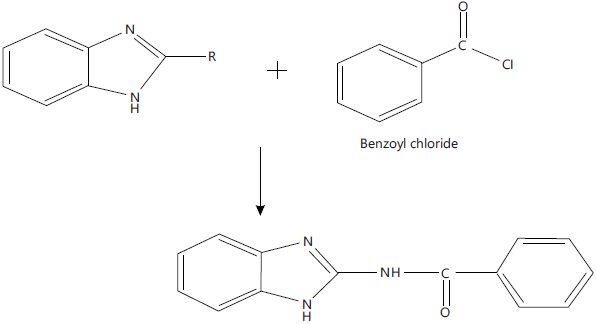
|
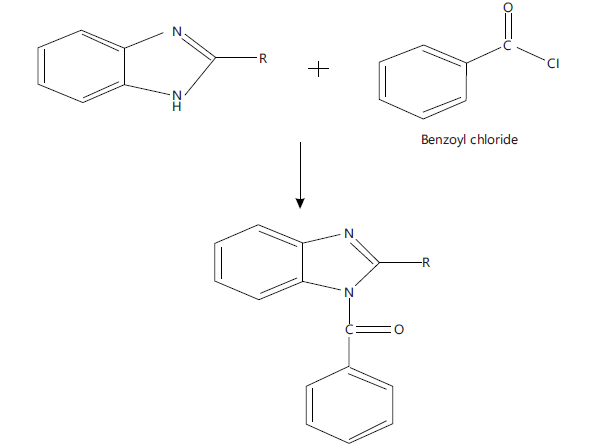
|
Synthesis of 2-methyl-1-H-benzo (d) imidazol-1-yl) (phenyl) methanone (L2): The 2-methylbenzimidazole (0.5 g) was dissolved in 10 mL of 10% sodium hydrogen carbonate solution and 1 g of benzoyl chloride added to the solution. The reaction mixture was shaken vigorously in a stoppered test tube. The mixture was then acidified with (37%) dilute hydrochloric acid, filtered, washed with ice-cold water, recrystallized with absolute ethanol and dried in anhydrous calcium chloride, yielding 53%, m.p. 300-302°C as shown in Fig. 2.
Attempts were also made to use the 2-chloromethyl benzimidazole as the starting material but the intermediate product was the 2-methylbenzimidazole.
Synthesis of the metal (II) complexes of L1 and L2: A mixture of L (2 mmol) and metal (II) salt, (1 mmol) in absolute ethanol (20 mL) was refluxed for 3 hrs. The precipitate filtered, washed with ice-cold water, recrystallized with absolute ethanol and dried over anhydrous calcium chloride. The proposed equation for the metal complexes can be written as12:
Where:
| M | = | Cu, Ni, Co, Mn and Zn | |
| L | = | L1, L2 | |
| W | = | H2O |
Antibacterial study: The ligands and their metal complexes were screened for antibacterial activities. The test organisms included six strains of bacteria typed cultures of the National Collection of Industrial Bacteria (NCIB) namely, Gram positive: Bacillus cereus NCIB 6349, Bacillus subtilis NCIB 3610, Bacillus stearothermophilus NCIB 8222. Gram-negative: Serratia marcescens NCIB 1377, Klebsiella pneumoniae NCIB 418, Escherichia coli, NCIB 86. The sensitivity testing of the compounds was determined using the agar well diffusion method17. Zones of inhibition and the effects of the compounds on bacterial strains were compared with those of standard antibiotics, ampicillin and streptomycin.
RESULTS
Physico-chemical characteristics: The ligands are white in colour and all the complexes possess a variety of colours ranging from white to deep green. The purity of the compounds was ascertained by melting point and TLC. The percentage yield of the ligands and metal complexes ranged from 51.47-67.87%. The melting points of the ligands are between the range of 265-267°C for L1 and 300-302°C for L2 while most of the complexes have melting points beyond 300°C except for some complexes of copper and zinc which decomposed at temperatures between 228 and 286°C. The colours, percentage yields and melting points of the ligands and the complexes as well as the Percentage Metal Analyses of the complexes of L1 and L2 are presented in Table 1.
Conductivity measurements: The molar conductivities for the complexes measured in methanol and DMF are shown in Table 1. They are in the range (6.94-21.10 Ω–1 cm2 mol–1) for L1 and 27.40-71.40 Ω–1 cm2 mol–1 for L2.
1H-NMR and 13C-NMR: The 1HNMR spectrum of ligand L1 (Fig. 3) gave peaks at δppm 8.37-8.03 (d, 2 H) and a multiple at δppm7.73-7.38 (7 H) while the 13C-NMR spectrum (Fig. 4) shows signals at 112-145 and 166.47 ppm. The signal at 40.0 ppm is due to the solvent.
| Table 1: | Physico-chemical and analytical data for the ligands and their complexes | |||
| Compounds | Colour |
Yield (%) |
Melting points (°C) |
Molar conductance (Ω–1cm2mol–1) |
Metal found (%) (calculated) |
| L1 | White |
62 |
265-267 |
- |
- |
| [Cu (L1)2Cl2].2H2O | Deep green |
58 |
284-286 |
19.09 |
9.85 (9.57) |
| [Ni (L1)2Cl2] | Dirty green |
57.27 |
>350 |
14.14 |
9.71 (9.76) |
| [Co (L1)2Cl2] | Pink |
55.09 |
>320 |
11.42 |
9.75 (9.37) |
| [Mn (L1)2Cl2] | Yellow |
67.87 |
>326 |
6.94 |
9.15 (11.70) |
| [Zn (L1)2Cl2] | White |
52.07 |
228-232 |
21.1 |
10.70 (11.14) |
| L2 | Dirty white |
53.30 |
300-302 |
- |
- |
| [Cu (L2)2Cl2].2H2O | Light green |
62.05 |
296-298 |
71.4 |
9.57 (10.00) |
| [Ni (L2)2Cl2].2H2O | Green |
56.52 |
305-307 |
47.6 |
9.46 (9.64) |
| [Mn (L2)2Cl2] | Yellow |
51.47 |
276-278 |
40.4 |
9.18 (9.54) |
| [Zn (L2)2Cl2] | White |
57.78 |
293-295 |
27.4 |
10.74 (11.71) |

|
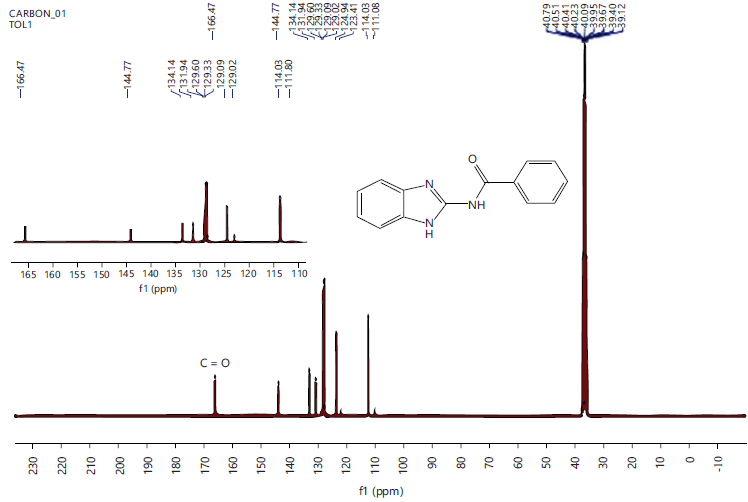
|
Similarly, the 1HNMR spectrum of ligand L2 (Fig. 5) gave peaks at 7.62-7.59 and 2.49 ppm while the 13C-NMR spectrum (Fig. 6) gave signals at 126.04-134.63, 165.92 and 39.96 ppm. The signal at 40.0 ppm is that of the solvent.
Infrared spectra: The infrared spectra of L1 and its complexes (Fig. 7-12) show absorption bands at 3175-3475 cm–1 for N-H, bands at 1626-1701, 1556-1626 and 1313-1340 cm–1 for C = O, C = N and C-N vibrational frequencies, respectively (Table 2). There were shifts in the stretching frequencies of C = O, C = N and C-N in the imidazole units of the benzimidazole rings in the spectra for the metal complexes, (Table 2 and Fig. 8-12). There were also downward shifts in the N-H stretching vibrational frequencies from 3475 cm–1 of the ligand, L1 to 3460, 3417, 3175, 3292 cm–1 for Cu (II), Ni (II),Co (II0 and Mn (II) complexes, respectively (Table 2). In addition, there are appearances of new bands at 434-526 and 617-678 cm–1 for the L1 complexes.
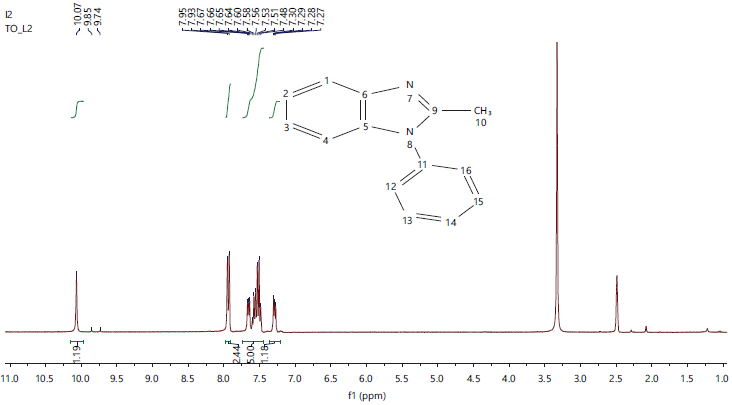
|
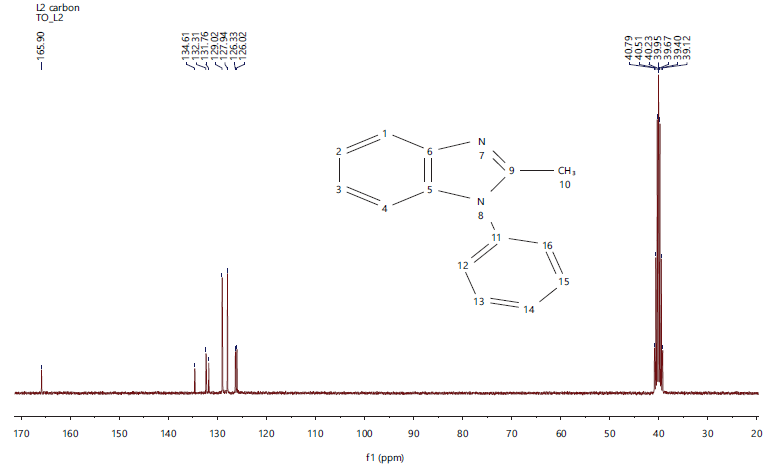
|
| Table 2: | Important infrared spectral bands (cm–1) of the benzoyl derivative, L1 and metal (II) complexes | |||
| Frequency of compounds | ν (NH) |
ν (C = O) |
ν (C = N) |
ν (C-N) |
ν (C = C) |
ν (M-O) |
ν (M-N) |
| L1 | 3475 |
1701 |
1626 |
1340 |
1600 |
- |
- |
| [Cu (L1)2Cl2].2H2O | 3460 |
1678 |
1633 |
1313 |
1589 |
669 |
526 |
| [Ni (L1)2Cl2].2H2O | 3417 |
1649 |
1579 |
1317 |
1556 |
632 |
434 |
| [Co (L1)2Cl2].2H2O | 3175 |
1655 |
1556 |
1315 |
1578 |
617 |
472 |
| [Mn (L1)2Cl2].2H2O | 3292 |
1674 |
1565 |
1341 |
1564 |
631 |
443 |
| [Zn (L1)2Cl2].2H2O | 3474 |
1626 |
1601 |
1340 |
1466 |
678 |
444 |
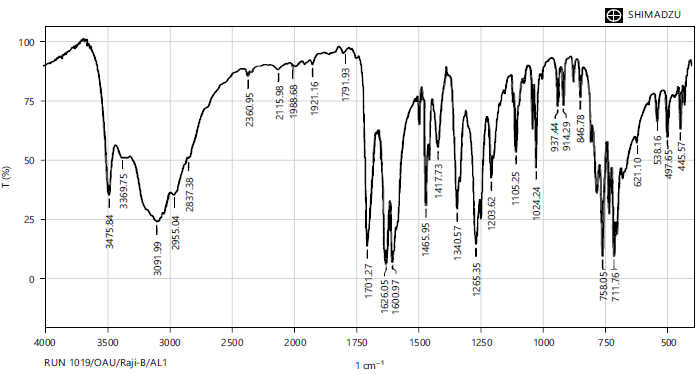
|
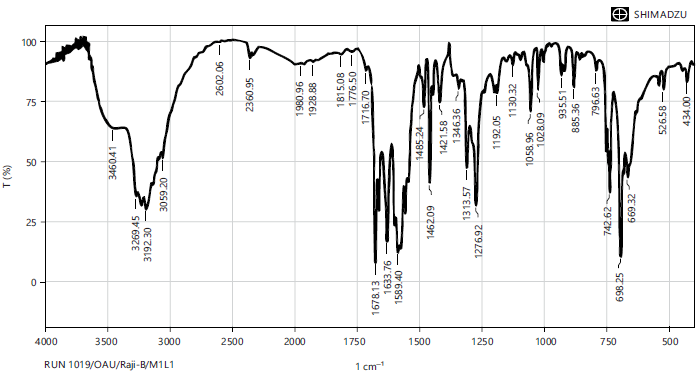
|
The infrared spectra of L2 and its complexes, (Fig. 13-17) show stretching vibrations bands at 3056-3132 cm–1 for C-H, bands at 1651-1658 cm–1 for C = O. There were also bands at 1525-1530 and 1280-1393 cm–1 (Table 3). There is appearance of new bands at 472-521 cm–1 for the L2 complexes.
Electronic spectra and magnetic moments: Electronic spectra of the ligands and the complexes were recorded in DMSO. There were bands at 231 and 299 nm for L1 and 228 nm for L2. (Table 4 and Fig. 18, 19).

|

|
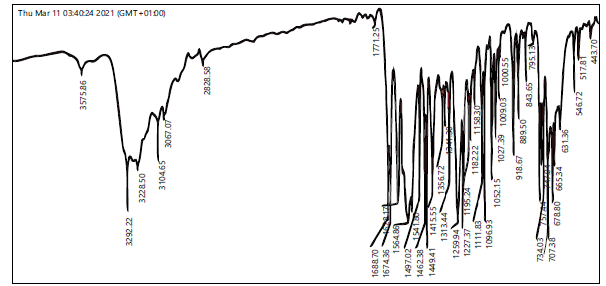
|
The electronic absorption spectra of Cu (II) complexes of L1 and L2 displayed one broad band with a slight shoulder at 768 and 783 nm, respectively (Fig. 20 and 21). The copper (II) complexes of L1 and L2 also gave magnetic moment values of 2.05 and 1.16 BM, respectively (Table 4).

|

|
| Table 3: | Important infrared spectral bands (cm–1) of the benzoyl derivative, L2 and metal (II) complexes | |||
| Frequency of compounds | ν (C-H) |
ν (C = O) |
ν (C-Hsp2) |
ν (C = C) |
ν (C = N) |
ν (C-N) |
ν (M-O) |
| L2 | 3057 |
1658 |
3273 |
1597 |
1526 |
1310 |
- |
| CuL2 | 3132 |
1654 |
3271 |
1577 |
1530 |
1393 |
521 |
| NiL2 | 3057 |
1655 |
3273 |
1527 |
1528 |
1310 |
473 |
| MnL2 | 3056 |
1656 |
3272 |
1498 |
1525 |
1323 |
519 |
| ZnL2 | 3056 |
1651 |
3271 |
1578 |
1529 |
1280 |
472 |
| L2: 2-methyl-1-H-benzo (d) imidazol-1-yl) (phenyl) methanone | |||||||
| Table 4: | Electronic spectra and magnetic moments of ligands and their Cu (II), Ni (II), Co (II), Mn (II) and Zn (II) complexes | |||
| Compounds | Intra-ligand transition (nm) |
Ligand field transition (nm) |
Magnetic moment μ eff (BM) |
Proposed geometry |
| L1 | 231,299 |
- |
- |
- |
| [Cu(L1)2Cl2].2H2O | 233,321 |
768 |
2.05 |
Octahedral |
| [Ni(L1)2Cl2].2H2O | 232,303 |
453,504,645 |
2 |
Octahedral |
| [Co(L1)2Cl2].2H2O | 234,306 |
497,646,764 |
4.86 |
Octahedral |
| [Mn(L1)2Cl2].2H2O | 233,300 |
493,783 |
1.35 |
Octahedral |
| [Zn(L1)2Cl2].2H2O | 301 |
- |
Diamagnetic (0.35) |
Octahedral |
| L2 | 228 |
- |
- |
- |
| [Cu(L2)2Cl2].2H2O | 292 |
783 |
1.16 |
Tetrahedral |
| [Ni(L2)2Cl2].2H2O | 267 |
613,779 |
2.12 |
Tetrahedral |
| [Mn(L2)2Cl2].2H2O | 270 |
596,773 |
2 |
Tetrahedral |
| [Zn(L2)2Cl2].2H2O | 277 |
- |
Diamagnetic (0.66) |
Tetrahedral |
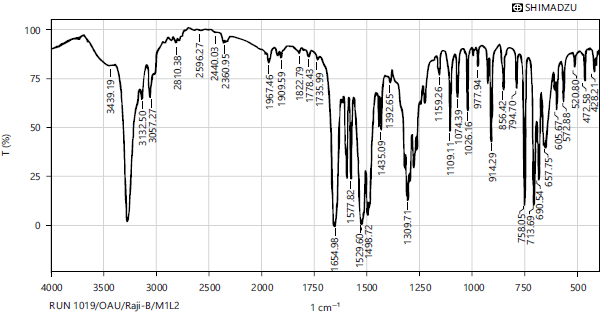
|

|
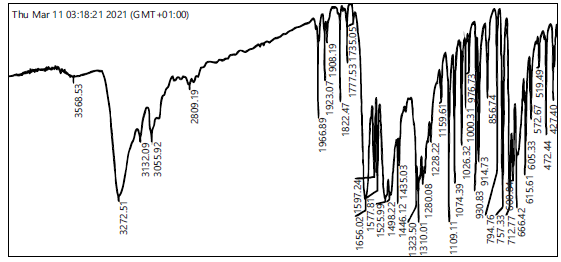
|
The visible spectrum for Ni (II) complex of L1 displayed three bands at 453, 504 and 645 nm, (Fig. 22 and Table 4). The magnetic moment values for the Ni (II) complexes were found to be 2.00 and 2.12 BM for L1 and L2, respectively.
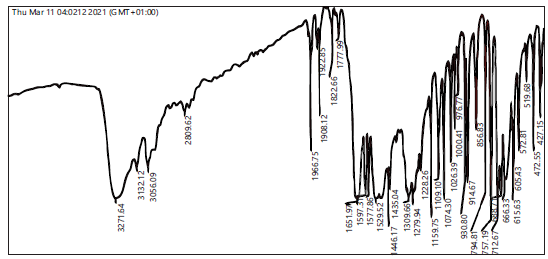
|

|

|
The visible spectrum for Ni (II) complex of L1 displayed three bands at 453, 504 and 645 nm, (Fig. 22 and Table 4). The magnetic moment values for the Ni (II) complexes were found to be 2.00 and 2.12 BM for L1 and L2, respectively.
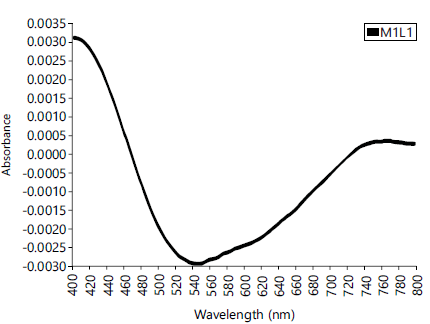
|
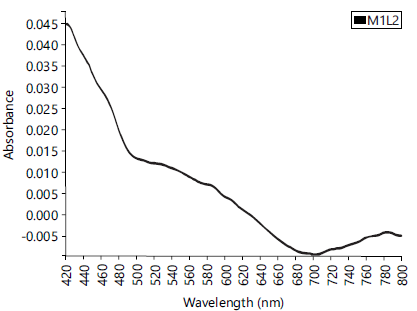
|

|
The complex of Co (II) L1, (Fig. 23) shows 3 electronic transitions at 497, 646 and 764 nm in the visible region while the Mn (II) Complex of L1 and Mn (II) complex of L2, (Fig. 24 and 25), respectively show weak bands at 493, 783 nm for L1 and 596 and 773 nm for L2, respectively. The magnetic moment values for the cobalt and Manganese complexes are shown in Table 4.
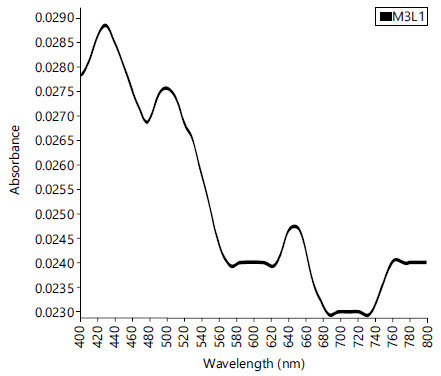
|

|

|
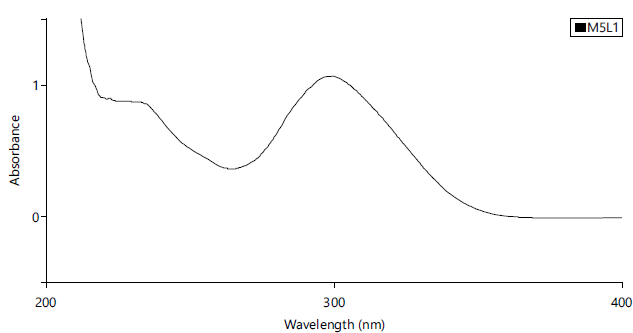
|

|
For the zinc complexes, bands at 237-299 nm were obtained in the ultraviolet region, (Fig. 26 and 27).
Proposed structures of the metal (II) complexes: The structures of the metal (II) complexes based on data from elemental analysis, FT-IR spectroscopic study, magnetic measurements, UV-Vis spectroscopy and molar conductivities are octahedral geometry for metal (II) L1 complexes and tetrahedral geometry for metal (II) L2 complexes are proposed in Fig. 28 and 29, respectively.
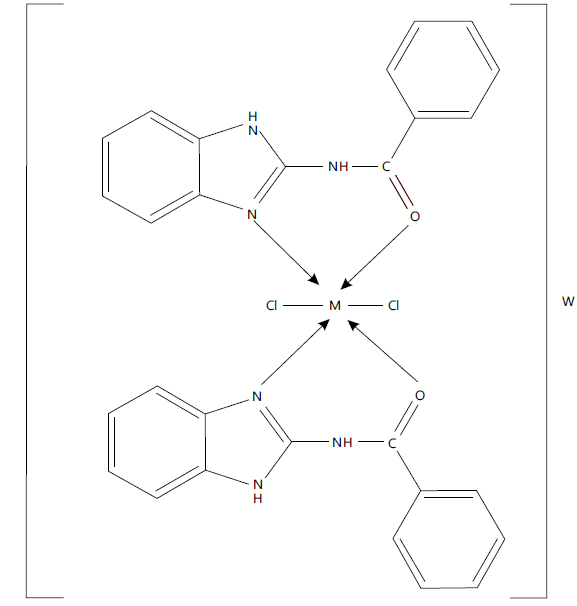
|

|
| Table 5: | Diameter of zones of inhibition of N-(1H-benzo [d] imidazol-2-yl) benzamide (L1) and metal complexes on selected bacteria isolates (mm) | |||
Concentrations at 50 mg mL–1 |
||||||||
| Bacteria | L1 |
CuL1 |
NiL1 |
CoL1 |
MnL1 |
ZnL1 |
Positive strep |
Control ampil |
| K. Pneumonia | 13 |
9 |
10 |
8 |
0 |
0 |
15 |
28 |
| Escherichia Coli | 8 |
13 |
22 |
32 |
16 |
20 |
28 |
18 |
| Bacillus Cereus | 9 |
0 |
0 |
0 |
0 |
9 |
24 |
15 |
| Bacillus Stearothermophilus | 20 |
16 |
18 |
27 |
17 |
15 |
25 |
12 |
| SerratiaMarcescens | 8 |
9 |
0 |
17 |
9 |
6 |
26 |
13 |
| Bacillus Subtilis | 8 |
11 |
0 |
15 |
9 |
0 |
26 |
NA |
| Negative Control | +++ |
+++ |
+++ |
+++ |
+++ |
+++ |
+++ |
+++ |
| +++: No zone of inhibition was produced (there was no growth around the well), STREP: Streptomycin, AMPIL: Ampicillin and NA: Not applicable | ||||||||
| Table 6: | Diameter of zones of inhibition of (2-methyl-1-H-benzo (d) imidazol-1-yl) (phenyl) methanone (L2) and metal complexes on selected bacteria isolates (mm) | |||
Concentrations at 50 mg mL–1 |
|||||||
| Bacteria | L2 |
CuL2 |
NiL2 |
MnL2 |
ZnL2 |
Positive strep |
Control ampil |
| K.Pneumonia | 0 |
0 |
0 |
0 |
0 |
15 |
28 |
| Escherichia Coli | 0 |
0 |
0 |
9 |
0 |
28 |
18 |
| Bacillus Cereus | 0 |
0 |
0 |
0 |
0 |
24 |
15 |
| Bacillus Stearothermophilus | 13 |
15 |
15 |
14 |
14 |
25 |
12 |
| Serratia Marcescens | 0 |
9 |
0 |
0 |
0 |
26 |
13 |
| Bacillus Subtilis | 0 |
0 |
0 |
0 |
0 |
26 |
NA |
| Negative Control | +++ |
+++ |
+++ |
+++ |
+++ |
+++ |
+++ |
| +++: No zone of inhibition produced (there was no growth around well) STREP: Streptomycin, AMPIL: Ampicillin and NA: Not applicable | |||||||
Antibacterial activity: The results of the antibacterial activity at 50 mg mL–1 against six bacteria with reference to streptomycin and ampicillin are given in Table 5 and 6, respectively. The L1 and its metal complexes have considerable effects on almost all the bacteria as evident in Table 5. At 50 mg mL–1, Klebsiella pneumoniae was found to be resistant to L1, MnL1 and ZnL1 complexes, similar to Bacillus cereus. The CoL1 possessed a greater inhibitory effect (32 mg mL–1) against Escherichia coli and Bacillus stearothermophilus than the reference streptomycin (28 mg mL–1) and ampicillin (18 mg mL–1).
Most of the bacterial isolates showed significant resistance against L2 and its metal complexes, (Table 6). However, CuL2, NiL2, MnL2 and ZnL2 showed higher activity against Bacillus stearothermophilus than the reference ampicillin.
DISCUSSION
The ligands are white in colour. The colours of the complexes arise from d-d transitions or charge transfer transitions. Most of the metal complexes have melting points beyond 300°C. These relatively high melting points of the metal complexes are characteristics of coordination compounds18. The Percentage Metal Analyses of the complexes of L1 and L2 showed good correlations between the experimental and theoretical values. All these physicochemical properties are summarized in Table 1.
The molar conductivities for the complexes in the range of 6.94-21.10 Ω–1 cm2 mol–1 for ML1 and 27.40-71.40 Ω–1 cm2 mol–1 for ML2 indicate that the complexes are non-electrolytic in nature. The values are presented in Table 1. The results were consistent and corresponded with the literature18.
The peaks for the protons at δppm8.37-8.03 (d, 2H) in the 1HNMR spectrum of ligand L1, (Fig. 3) are due to benzimidazole protons while the multiplet at δppm7.73-7.38 (7H) are due to the aromatic protons. Signals at 112-145 ppm in the 13C-NMR spectrum (Fig. 4) are for the carbon on both the benzimidazole and the aromatic ring while the signal at 166.47 ppm, (a large down-field shift) is for carbonyl carbon. The signal at 40.0 ppm is due to the solvent. Similarly, 1HNMR spectrum of ligand L2 (Fig. 5) shows peaks for benzimidazole protons between 7.62-7.59 ppm. The signal at 2.49 ppm corresponds to the alkyl proton. The 13C-NMR spectrum (Fig. 6) shows signals at 126.04-134.63 ppm for the carbon on the benzimidazole and phenyl part of the ring. The 165.92 ppm is for the carbonyl carbon which is down-field due to both sp2 hybridization and to the double bond to oxygen. The signal for the alkyl carbon appeared upfield with a chemical shift of 39.96 ppm with that of the solvent at 40.0 ppm. The assignments of the 1HNMR and 13C-NMR spectroscopic data were in agreement with the proposed molecular structures19.
The shifts in the stretching frequencies of N-H, C = O, C = N and C-N in the imidazole units of the benzimidazole ring on coordination of L1 with metal ions, Fig. (8-12) are indications of the involvement of these groups in the coordination of L1 to the metal ions. These were similar to those obtained by Sadeek et al.20, Raducka et al.21 and Srivastva et al.22. The downward shifts in the N-H stretching vibrational frequencies from 3475cm–1of the ligand, L1 to 3460, 3417, 3175, 3292 cm–1 for Cu (II), Ni (II), Co (II0 and Mn (II) complexes, respectively (Table 2) are indications of coordination through the imidazole nitrogen of the imidazole ring. These changes were similar to those found in the literature20,21. The stretching vibrations bands in the infrared spectrum of L2 and its complexes, (Fig. 13-17) at 3056-3273 cm–1 could be attributed to C-H, bands while those at 1651-1658 cm–1 are for C = O. The bands at 1525-1530 and 1280-1393 cm–1 (Table 3) are characteristics of C = N and C-N vibrational frequencies, respectively23.
Metal-ligand vibrations are generally observed in the far-IR region and usually give valuable information regarding the bonding of ligands to metal ions. Thus, further evidence of coordination of L1 and L2 with metal ions is shown by the appearance of new weak bands at 434-526 and 617-678 cm–1 which can be assigned to Metal-nitrogen (M-N) and metal-oxygen (M-O) vibrations, respectively for L1 complexes and bands at 472-521 cm–1 assigned to metal-oxygen (M-O) vibration for L2 complexes. These were consistent with values obtained in the literature20,24.
The electronic bands at 231 and 299 nm in the UV spectrum of L1 and 228 nm in the UV spectrum of L2, (Table 4 and Fig. 18, 19) correspond to n→σ*, n→π* and π→π* transitions of the major chromophores, -N-H, -C = N and C = C present in the ligand molecules. Shifts in the position of the bands were observed on coordination to the metal ions. The slight shoulders at 768 and 783 nm in the electronic absorption spectra of Cu (II) complexes of L1 and L2, respectively, are due to the Jahn-Teller effect Fig. (20 and 21). This is characteristic of Cu (II) complexes in an octahedral or tetrahedral environment with 2Eg→2T2g transition25.
The magnetic moment values of 2.05 and 1.16 BM for the copper (II) complexes of L1 and L2, respectively indicate their mononuclear nature with one unpaired electron and suggest a distorted Octahedral and Tetrahedral geometries, respectively as calculated spin only magnetic moment for copper is 1.73 BM. This shows that it is paramagnetic26.
The visible spectra for the Ni (II) complex of L1, (Fig. 22) displayed three bands at 453, 504 and 645 nm which can be attributed to the d-d electronic transitions 3A2g(F)→3T2g(F), 3A2g(F)→3T1g (F) and 3A2g (F)→3T1g (P), respectively. Furthermore, μeff of Ni (II) d8 was found to be 2.00 and 2.12 BM for L1 and L2, respectively. These supported the octahedral and tetrahedral geometries of the Ni (II) complexes26.
The 3 electronic transitions, 497, 646 and 764 nm in the visible region for Co (II) complex of L1 (Fig. 23) are most likely due to 4T1g→4T2g, 4T1g→4A2g and 4T1g→4T1g (P), respectively. These transitions correspond to Co (II) in an octahedral complex. The 4.86 BM magnetic moment value for [Co(L1)2Cl2] also suggests an Octahedral arrangement26,27. Octahedral Mn (II) complex of L1 and Tetrahedral Mn (II)complex of L2,
Fig. (24 and 25) show weak bands at 493, 783 nm for L1 and 596, 773 nm for L2, respectively. The 1.35 and 2.0 BM magnetic moment values for MnL1 and MnL2 complexes indicate paramagnetism in octahedral and tetrahedral environments, respectively25,28.
For the zinc complexes, the bands, 237-299 nm in the ultraviolet region are due to charge transfer Fig. (26 and 27). The almost zero magnetic moment values for the Zn complexes (Table 4) confirm that they are diamagnetic29.
Thus, the structures of the metal (II) complexes based on data from elemental analysis, FT-IR spectroscopic study, magnetic measurements, UV-Vis spectroscopy and molar conductivities are octahedral geometry for metal (II) L1 complexes and tetrahedral geometry for metal (II) L2 complexes. The metal-ligand coordination modes observed in this work were similar to those found by Téllez et al.15 in the study of the coordination behaviour of benzimidazole, 2-substituted benzimidazoles and benzothiazoles towards transition metal ions. The results of the antibacterial activities of L1 and its metal complexes at 50 mg mL–1 against six bacteria with reference to streptomycin and ampicillin presented in Table 5 indicate that L1 and its metal complexes have considerable effects on the bacteria. At 50 mg mL–1, Klebsiella pneumoniae was found to be resistant to L1, MnL1 and ZnL1 complexes. Similarly, Bacillus cereus CoL1 possessed a greater inhibitory effect (32 mg mL–1) against Escherichia coli and Bacillus stearothermophilus than the reference streptomycin (28 mg mL–1) and ampicillin (18 mg mL–1). Most of the bacterial isolates showed significant resistance against L2 and its metal complexes, (Table 6). However, CuL2, NiL2, MnL2 and ZnL2 showed higher activity against Bacillus stearothermophilus than the reference ampicillin. The improved activities of the metal complexes may be due to the nature of the metal ion and can also be attributed to an increase in cell permeability which eventually facilitates absorption through the lipid of the selected microorganisms23,26.
A literature survey revealed the importance of the substitutions at 1, 2 and 5 positions of the benzimidazole ring for their pharmacological activities7,8. The antimicrobial activities of a series of benzimidazole-pyrazole hybrids have also been correlated with the various groups present on the molecule and their pharmaceutical properties discussed. At the same time, the role of electron withdrawing group in improving antimicrobial activities was supported by the studies of Kumar et al.30. Studies have also shown that metal complexes are more active compared to the uncomplexed ligands31,32.
Thus, as the search for more effective antimicrobial agents continues, more research work is expected for more explorations along these directions as well as examining the effect of different functional groups and substituents in the design of additional benzimidazole derivatives with antimicrobial activities.
CONCLUSION
This study synthesized two benzoyl derivatives of 2-substituted benzimidazoles, L1 and L2 and established their chelating properties and the anti-bacterial activities of both the ligands and the metal complexes. L1 acts as a bidentate ligand bonding through imidazole nitrogen and carbonyl oxygen resulting into octahedral geometry while L2 acts as a monodentate ligand through the carbonyl oxygen resulting in tetrahedral geometry. The metal complexes showed higher anti-bacterial activities than their ligands but CoL1 possessed a greater inhibitory effect against Escherichia coli and Bacillusstearothermo philus than the reference streptomycin and ampicillin. The anti-bacterial activities could further be explored by incorporating other substituents on the 2-substituted benzimidazole group.
SIGNIFICANCE STATEMENT
The study has added to the existing literature, the synthesis of two benzoyl derivatives of 2-substituted benzimidazoles namely N-(1H-benzo[d]imidazol-2-yl) benzamide (L1) and (2-methyl-1-H-benzo (d) imidazol-1-yl) (phenyl) methanone (L2). It also provided information on the chelating properties of the derivatives which are also essential as metal complexes of derivatives showed better activity than the ligands. Furthermore, the findings on the antibacterial activities of the benzoyl derivatives and the metal complexes are very beneficial in pharmacological applications.
REFERENCES
- Song, D. and S. Ma, 2016. Recent development of benzimidazole-containing antibacterial agents. Chem. Med. Chem., 11: 646-659.
- He, Y., J. Yang, B. Wu, L. Risen and E.E. Swayze, 2004. Synthesis and biological evaluations of novel benzimidazoles as potential antibacterial agents. Bioorg. Med. Chem. Lett., 14: 1217-1220.
- Aghatabay, N.M., A. Neshat, T. Karabiyik, M. Somer, D. Haciu and B. Dülger, 2007. Synthesis, characterization and antimicrobial activity of Fe(II), Zn(II), Cd(II) and Hg(II) complexes with 2,6-bis(benzimidazol-2-yl) pyridine ligand. Eur. J. Med. Chem., 42: 205-213.
- Ansari, K.F. and C. Lal, 2009. Synthesis and evaluation of some new benzimidazole derivatives as potential antimicrobial agents. Eur. J. Med. Chem., 44: 2294-2299.
- Ansari, K.F. and C. Lal, 2009. Synthesis, physicochemical properties and antimicrobial activity of some new benzimidazole derivatives. Eur. J. Med. Chem., 44: 4028-4033.
- Kazimierczuk, Z., J.A. Upcroft, P. Upcroft, A. Górska, B. Starościak and A. Laudy, 2002. Synthesis, antiprotozoal and antibacterial activity of nitro- and halogeno-substituted benzimidazole derivatives. Acta Biochim. Pol., 49: 185-195.
- Devereux, M., M. McCann, D.O. Shea, R. Kelly and D. Egan et al., 2004. Synthesis, antimicrobial activity and chemotherapeutic potential of inorganic derivatives of 2-(4′-thiazolyl)benzimidazole{thiabendazole}: X-ray crystal structures of [Cu(TBZH)2Cl]Cl·H2O·EtOH and TBZH2NO3 (TBZH=Thiabendazole). J. Inorg. Biochem., 98: 1023-1031.
- Goker, H., C. Kus, D.W. Boykin, S. Yildiz and N. Altanlar, 2002. Synthesis of some new 2-substituted-phenyl-1H-benzimidazole-5-carbonitriles and their potent activity against Candida species. Bioorg. Med. Chem., 10: 2589-2596.
- Hranjec, M., K. Starcevic, S.K. Pavelic, P. Lucin, K. Pavelic and G.K. Zamola, 2011. Synthesis, spectroscopic characterization and antiproliferative evaluation in vitro of novel Schiff bases related to benzimidazoles. Eur. J. Med. Chem., 46: 2274-2279.
- Gümüş, F., Ö. Algül, G. Eren, H. Eroğlu, N. Diril, S. Gür and A. Özkul, 2003. Synthesis, cytotoxic activity on MCF-7 cell line and mutagenic activity of platinum(II) complexes with 2-substituted benzimidazole ligands. Eur. J. Med. Chem., 38: 473-480.
- Tunçbilek, M., T. Kiper and N. Altanlar, 2009. Synthesis and in vitro antimicrobial activity of some novel substituted benzimidazole derivatives having potent activity against MRSA. Eur. J. Med. Chem., 44: 1024-1033.
- Salahuddin, M. Shaharyar and A. Mazumder, 2017. Benzimidazoles: A biologically active compounds. Arabian J. Chem., 10: S157-S173.
- Göker, H., S. Özden, S. Yıldız and D.W. Boykin, 2005. Synthesis and potent antibacterial activity against MRSA of some novel 1,2-disubstituted-1H-benzimidazole-N-alkylated-5-carboxamidines. Eur. J. Med. Chem., 40: 1062-1069.
- Krishnanjaneyulu, I.S., G. Saravanan, J. Vamsi, P. Supriya, J.U. Bhavana and M.V.S. Kumar, 2014. Synthesis, characterization and antimicrobial activity of some novel benzimidazole derivatives. J. Adv. Pharm. Technol. Res., 5: 21-27.
- Téllez, F., H. López-Sandoval, S.E. Castillo-Blum and N. Barba-Behrens, 2008. Coordination behavior of benzimidazole, 2-substituted benzimidazoles and benzothiazoles, towards transition metal ions. ARKIVOC, 39: 245-275.
- Neelamma, M., P.V. Rao and G.H. Anuradha, 2011. Synthesis and structural studies on transition metal complexes derived from 4-Hydroxy-4-methyl–2-pentanone-1H-benzimidazol-2-yl-hydrazone. J. Chem., 8: 29-36.
- Balouiri, M., M. Sadiki and S.K. Ibnsouda, 2016. Methods for in vitro evaluating antimicrobial activity: A review. J. Pharm. Anal., 6: 71-79.
- El-Sonbati, A.Z., M.A. Diab, S.M. Morgan, M.I. Abou-Dobara and A.A. El-Ghettany, 2020. Synthesis, characterization, theoretical and molecular docking studies of mixed-ligand complexes of Cu(II), Ni(II), Co(II), Mn(II), Cr(III), UO2(II) and Cd(II). J. Mol. Struct., 1200.
- Podunavac-Kuzmanovic, S.O., V.M. Leovac, N.U. Perisic-Janjic, J. Rogan and J. Balaz, 1999. Complexes cobalt(II), zinc(II) and copper(II) with some newly synthesized benzimidazole derivatives and their antibacterial activity. J. Serb. Chem. Soc., 64: 381-388.
- Sadeek, S.A., M.S. El-Attar and S.M. Abd El-Hamid, 2013. Preparation and characterization of new tetradentate Schiff base metal complexes and biological activity evaluation. J. Mol. Struct., 1051: 30-40.
- Raducka, A., M. Świątkowski, I. Korona-Głowniak, B. Kaproń and T. Plech et al., 2022. Zinc coordination compounds with benzimidazole derivatives: Synthesis, structure, antimicrobial activity and potential anticancer application. Int. J. Mol. Sci., 23.
- Srivastva, A.N., N.P. Singh and C.K. Shriwastaw, 2016. In vitro antibacterial and antifungal activities of binuclear transition metal complexes of ONNO Schiff base and 5-methyl-2,6-pyrimidine-dione and their spectroscopic validation. Arabian J. Chem., 9: 48-61.
- Agh-Atabay, N., 2003. Synthesis and investigation of antimicrobial activity of some bisbenzimidazole-derived chelating agents. Eur. J. Med. Chem., 38: 875-881.
- Su, W.Y., R.K. Pan, J.L. Song, G.B. Li and S.G. Liu, 2019. Synthesis, crystal structures and cytotoxic activity of two zinc(II) complexes derived from benzimidazole derivatives. Polyhedron, 161: 268-275.
- Kargar, H., A.A. Ardakani, M.N. Tahir, M. Ashfaq and K.S. Munawar, 2021. Synthesis, spectral characterization, crystal structure and antibacterial activity of nickel(II), copper(II) and zinc(II) complexes containing ONNO donor Schiff base ligands. J. Mol. Struct., 1233.
- Chandra, S. and U. Kumar, 2005. Spectral and magnetic studies on manganese(II), cobalt(II) and nickel(II) complexes with Schiff bases. Mol. Biomol. Spectrosc., 61: 219-224.
- Moreno-Alvero, M., F. Luna-Giles, F.J. Barros-García, E. Viñuelas-Zahínos and M.C. Fernández-Calderón, 2021. Cobalt(II) complexes derived from a 2-aminobenzimidazole-thiazoline ligand: Synthesis, characterization, crystal structures and antimicrobial activity studies. Polyhedron, 207.
- Sridharan, K., 2016. Spectral Methods in Transition Metal Complexes. 1st Edn., Elsevier, Amsterdam, ISBN: 9780128096543, Pages: 202.
- Mandewale, M.C., S. Kokate, B. Thorat, S. Sawant and R. Yamgar, 2019. Zinc complexes of hydrazone derivatives bearing 3,4-dihydroquinolin-2(1H)-one nucleus as new anti-tubercular agents. Arabian J. Chem., 12: 4479-4489.
- Kumar, K., D. Awasthi, S.Y. Lee, J.E. Cummings, S.E. Knudson, R.A. Slayden and I. Ojima, 2013. Benzimidazole-based antibacterial agents against Francisella tularensis. Bioorg. Med. Chem., 21: 3318-3326.
- Nair, R., A. Shah, S. Baluja and S. Chanda, 2006. Synthesis and antibacterial activity of some Schiff base complexes. J. Serb. Chem. Soc., 71: 733-744.
- Arif, M., M.M.R. Qurashi and M.A. Shad, 2011. Metal-based antibacterial agents: Synthesis, characterization, and in vitro biological evaluation of cefixime-derived Schiff bases and their complexes with Zn(II), Cu(II), Ni(II), and Co(II). J. Coord. Chem., 64: 1914-1930.
How to Cite this paper?
APA-7 Style
Durosinmi,
L.M., Akinyele,
O.F., Raji,
B.A., Fadare,
O.A., Oluduro,
A.O. (2023). Biological Activities and Chelating Properties of New Benzoyl Derivatives of 2-Substituted Benzimidazoles. Science International, 11(1), 34-53. https://doi.org/10.17311/sciintl.2023.34.53
ACS Style
Durosinmi,
L.M.; Akinyele,
O.F.; Raji,
B.A.; Fadare,
O.A.; Oluduro,
A.O. Biological Activities and Chelating Properties of New Benzoyl Derivatives of 2-Substituted Benzimidazoles. Sci. Int 2023, 11, 34-53. https://doi.org/10.17311/sciintl.2023.34.53
AMA Style
Durosinmi
LM, Akinyele
OF, Raji
BA, Fadare
OA, Oluduro
AO. Biological Activities and Chelating Properties of New Benzoyl Derivatives of 2-Substituted Benzimidazoles. Science International. 2023; 11(1): 34-53. https://doi.org/10.17311/sciintl.2023.34.53
Chicago/Turabian Style
Durosinmi, Lateefa, Moyosore, Olawale Folorunso Akinyele, Bolaji Abibu Raji, Olatomide Ayodeji Fadare, and Anthonia Olubisi Oluduro.
2023. "Biological Activities and Chelating Properties of New Benzoyl Derivatives of 2-Substituted Benzimidazoles" Science International 11, no. 1: 34-53. https://doi.org/10.17311/sciintl.2023.34.53

This work is licensed under a Creative Commons Attribution 4.0 International License.



